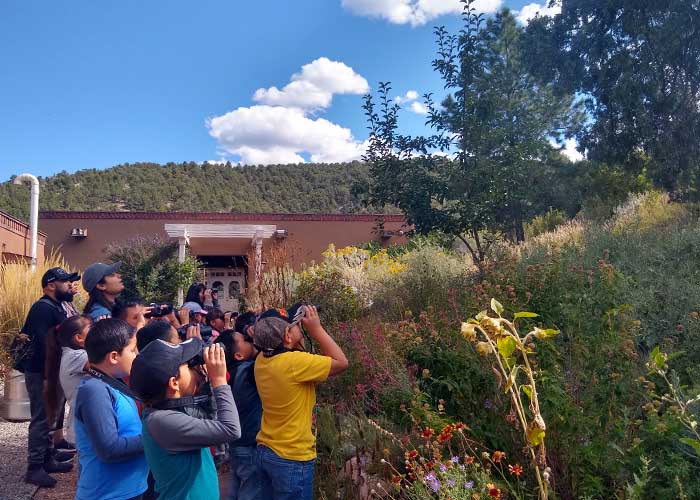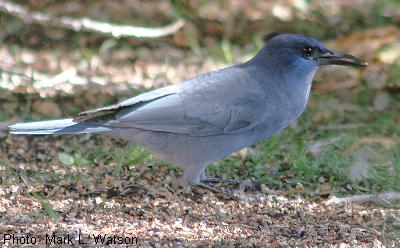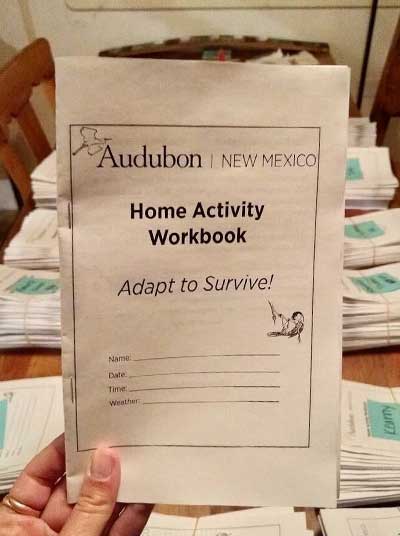Modifying Wildlife Activities for Learning from Home
Following is a selected project highlight from the Share with Wildlife mission to assist all New Mexico wildlife in need, no matter what species.
Modifying Wildlife Activities for Learning from Home

Santa Fe Public School students birding at Randall Davey Audubon Center in Fall 2019. (Katie Weeks)
What is an “adaptation” and how are birds adapted to different environments and to eat different things? What are the key elements of an animal’s “habitat” and how can you make your own backyard more appealing to wildlife?
This spring, Audubon New Mexico used Share with Wildlife funds to produce workbooks that students could work through at home to learn about and answer these questions and more. Audubon New Mexico had started the spring semester planning to update their Outdoor Field Science curriculum to better align with the Public Education Department’s STEM Ready! Science Standards. They were then going to have both classroom- and field-based interactions with students to implement the updated science curriculum, which focuses on New Mexico wildlife; their habitats, biology, and conservation; and scientific observation with an emphasis on piñon-juniper habitats and the birds that live in them. Then restrictions and closures associated with COVID-19 required that they quickly modify their plans for providing environmental educational experiences for students from Santa Fe Public Schools.
Audubon New Mexico normally gives students an opportunity to explore and make observations of wildlife habitat elements and wildlife sign in the piñon-juniper woodland at Randall Davey Audubon Center in northern Santa Fe. They learn about fundamental ecological and biological concepts including food webs, ecosystems, and animal anatomy and adaptations. They have an opportunity to learn how to look for birds and observe their behavior using binoculars. They also examine skulls and pelts of different animals to learn about the connections between how an animal looks, how they behave, and what they eat.

Pinyon jay. (Mark Watson)
To ensure that students could still receive environmental education when they were sent home, Audubon New Mexico developed two workbooks, in both English and Spanish, and worked with Santa Fe Public Schools to distribute them through food pickup sites, thereby targeting students who lack internet access at home. They also distributed the workbooks digitally to teachers who originally scheduled field trips to Randall Davey Audubon Center for spring 2020 but had to cancel them. The “Backyard Habitat Explorer” workbook has students learn about the concept of a habitat, identify habitat elements and animal sign in their backyard or neighborhood, map a habitat, and consider what could be done to improve the habitat that they mapped for wildlife. They also learn about the pinyon jay, a bird closely associated with piñon-juniper woodland habitat. The “Adapt to Survive!” workbook has students learn about adaptations; write down what they see, smell, and hear outside their house; design a bird that could survive in New Mexico during the summer; and complete an activity that helps them learn about how different bird beak shapes and sizes help birds better eat different kinds of foods.
Audubon New Mexico has continued their work aligning their curriculum with STEM Ready! Science Standards and looks forward to continued adaptation of wildlife-related educational materials to the new educational landscape in New Mexico.

Workbooks compiled for distribution. (Sally Maxwell)

Home activity workbook. (Sally Maxwell)
Legal Disclaimer:
EIN Presswire provides this news content "as is" without warranty of any kind. We do not accept any responsibility or liability for the accuracy, content, images, videos, licenses, completeness, legality, or reliability of the information contained in this article. If you have any complaints or copyright issues related to this article, kindly contact the author above.
